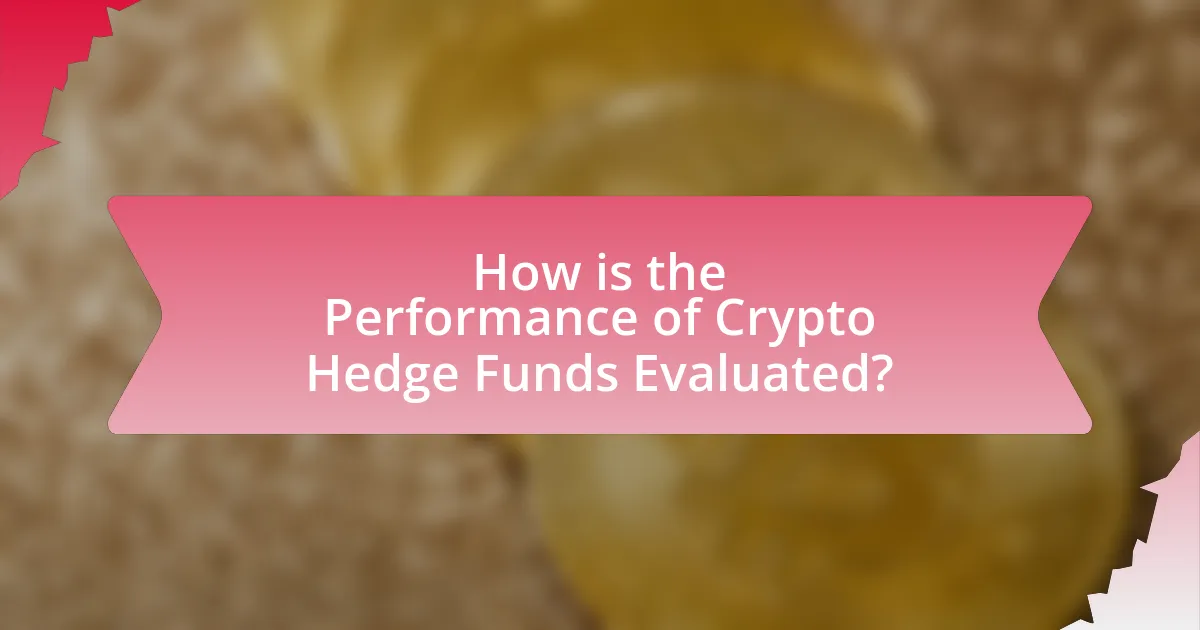Crypto hedge funds are specialized investment vehicles that focus on trading cryptocurrencies and digital assets, employing strategies such as long/short equity, arbitrage, and market making to generate returns. This article evaluates the performance of crypto hedge funds, highlighting key metrics like return on investment, volatility, and risk-adjusted returns, while also discussing the unique challenges associated with their evaluation, including data limitations and market manipulation. Additionally, it explores the impact of regulatory changes, external factors, and technological advancements on fund performance, providing best practices for investors to effectively analyze and assess these funds in a rapidly evolving market.

What are Crypto Hedge Funds?
Crypto hedge funds are investment funds that primarily focus on trading cryptocurrencies and digital assets. These funds employ various strategies, including long/short equity, arbitrage, and market making, to generate returns for their investors. According to a report by PwC and Elwood Asset Management, the crypto hedge fund industry has seen significant growth, with over 150 funds operating globally as of 2021, managing billions in assets. This growth reflects the increasing interest in cryptocurrencies as an asset class and the potential for high returns, albeit with substantial risks.
How do Crypto Hedge Funds differ from traditional hedge funds?
Crypto hedge funds primarily differ from traditional hedge funds in their investment focus and asset class, as crypto hedge funds invest exclusively in cryptocurrencies and blockchain-related assets, while traditional hedge funds typically invest in stocks, bonds, and other conventional financial instruments. This distinction leads to varying risk profiles; crypto hedge funds often experience higher volatility due to the nascent and speculative nature of the cryptocurrency market, which can result in significant price fluctuations. Additionally, regulatory environments differ, with crypto hedge funds facing less established regulations compared to traditional hedge funds, which are subject to stringent oversight by financial authorities. These factors contribute to the unique operational strategies and performance metrics used to evaluate crypto hedge funds compared to their traditional counterparts.
What investment strategies do Crypto Hedge Funds typically employ?
Crypto hedge funds typically employ strategies such as long/short equity, arbitrage, market making, and quantitative trading. Long/short equity involves taking long positions in undervalued cryptocurrencies while shorting overvalued ones, allowing funds to profit from price discrepancies. Arbitrage strategies exploit price differences across exchanges, capitalizing on inefficiencies in the market. Market making involves providing liquidity by placing buy and sell orders, earning profits from the spread. Quantitative trading relies on algorithms and statistical models to identify trading opportunities based on historical data. These strategies are supported by the volatile nature of the cryptocurrency market, which offers significant opportunities for profit.
What types of assets do Crypto Hedge Funds invest in?
Crypto hedge funds primarily invest in cryptocurrencies, blockchain-based assets, and digital tokens. These funds often focus on major cryptocurrencies like Bitcoin and Ethereum, as well as altcoins and initial coin offerings (ICOs). Additionally, they may invest in derivatives such as futures and options related to cryptocurrencies, providing exposure to price movements without direct ownership. The diversification into various digital assets allows crypto hedge funds to manage risk and capitalize on market volatility, which is a characteristic feature of the cryptocurrency market.
Why are Crypto Hedge Funds gaining popularity?
Crypto hedge funds are gaining popularity due to their potential for high returns and the increasing institutional interest in cryptocurrencies. The volatility of the crypto market presents unique opportunities for hedge funds to capitalize on price fluctuations, attracting investors seeking significant gains. According to a report by PwC, 46% of hedge fund managers surveyed in 2021 indicated that they were investing in digital assets, reflecting a growing trend towards crypto investments. Additionally, the rise of decentralized finance (DeFi) and innovative trading strategies further enhance the appeal of crypto hedge funds, making them an attractive option for both retail and institutional investors.
What market trends are driving interest in Crypto Hedge Funds?
Growing institutional adoption and regulatory clarity are the primary market trends driving interest in Crypto Hedge Funds. Institutional investors, including pension funds and family offices, are increasingly allocating capital to cryptocurrencies, seeking diversification and potential high returns. According to a report by Fidelity Digital Assets, 36% of institutional investors in the U.S. have invested in digital assets, indicating a significant shift in market sentiment. Additionally, clearer regulatory frameworks in regions like the U.S. and Europe are providing a safer environment for investment, further attracting hedge funds to the crypto space. This combination of institutional interest and regulatory support is fostering a more robust market for Crypto Hedge Funds.
How do regulatory changes impact the growth of Crypto Hedge Funds?
Regulatory changes significantly impact the growth of crypto hedge funds by influencing their operational frameworks and investor confidence. For instance, the introduction of clearer regulations can enhance legitimacy and attract institutional investors, as seen in jurisdictions like Switzerland, where regulatory clarity has led to a surge in crypto fund registrations. Conversely, stringent regulations can stifle growth by increasing compliance costs and limiting market access, as evidenced by the decline in crypto fund launches following the implementation of the SEC’s stricter guidelines in the United States. Thus, the nature of regulatory changes directly correlates with the expansion or contraction of crypto hedge funds in the market.

How is the Performance of Crypto Hedge Funds Evaluated?
The performance of crypto hedge funds is evaluated primarily through metrics such as return on investment (ROI), volatility, and Sharpe ratio. ROI measures the percentage gain or loss relative to the initial investment, providing a clear indication of profitability. Volatility assesses the degree of variation in the fund’s returns, indicating risk levels associated with the investment. The Sharpe ratio, which compares the fund’s excess return to its standard deviation, helps investors understand the risk-adjusted return, allowing for better comparisons across different funds. These metrics are essential for investors to gauge the effectiveness and risk profile of crypto hedge funds in a highly volatile market.
What metrics are commonly used to assess Crypto Hedge Fund performance?
Common metrics used to assess Crypto Hedge Fund performance include the Sharpe Ratio, Sortino Ratio, Maximum Drawdown, and Alpha. The Sharpe Ratio measures risk-adjusted returns by comparing the fund’s excess return to its volatility, providing insight into how well the fund compensates investors for taking on risk. The Sortino Ratio is similar but focuses only on downside volatility, making it particularly useful for assessing funds that aim to minimize losses. Maximum Drawdown quantifies the largest peak-to-trough decline in the fund’s value, indicating potential risk exposure. Alpha represents the fund’s performance relative to a benchmark, showing the value added by the fund manager’s investment decisions. These metrics are essential for investors to evaluate the risk and return profile of crypto hedge funds effectively.
How do risk-adjusted returns factor into performance evaluation?
Risk-adjusted returns are crucial in performance evaluation as they provide a measure of how much return an investment generates relative to the risk taken. This metric allows investors to compare the performance of different investments on a level playing field, accounting for the volatility and risk associated with each asset. For instance, the Sharpe ratio, a common risk-adjusted return metric, quantifies the excess return per unit of risk, enabling investors to assess whether the returns justify the risks involved. By using risk-adjusted returns, investors can make more informed decisions, ensuring that they are not only chasing high returns but also considering the potential risks that accompany those returns.
What role does volatility play in measuring performance?
Volatility serves as a critical metric in measuring the performance of crypto hedge funds by indicating the degree of price fluctuations over a specific period. High volatility often suggests greater risk, which can impact the fund’s returns; for instance, a study by the CFA Institute found that hedge funds with higher volatility tend to have higher average returns, reflecting the risk-return trade-off. This relationship underscores the importance of volatility in assessing not only potential gains but also the inherent risks associated with investment strategies in the volatile cryptocurrency market.
How do benchmarks influence the evaluation of Crypto Hedge Funds?
Benchmarks significantly influence the evaluation of Crypto Hedge Funds by providing a standard against which fund performance can be measured. These benchmarks, often based on indices like Bitcoin or Ethereum performance, allow investors to assess whether a hedge fund is delivering returns that justify its risk profile. For instance, if a crypto hedge fund consistently underperforms relative to a benchmark index, it may indicate poor management or strategy inefficiencies. Conversely, outperformance can signal effective investment strategies. According to a report by PwC, 70% of institutional investors use benchmarks to evaluate fund performance, underscoring their importance in decision-making processes.
What are the most relevant benchmarks for Crypto Hedge Funds?
The most relevant benchmarks for Crypto Hedge Funds include the Bloomberg Galaxy Crypto Index, the Bitwise 10 Crypto Index, and the HFR Cryptocurrency Index. These benchmarks provide a standardized measure of performance for crypto hedge funds by tracking the price movements of a diversified basket of cryptocurrencies. For instance, the Bloomberg Galaxy Crypto Index is designed to measure the performance of the largest and most liquid cryptocurrencies, while the Bitwise 10 Crypto Index includes the top ten cryptocurrencies by market capitalization, offering a comprehensive view of the market. The HFR Cryptocurrency Index specifically tracks the performance of hedge funds that invest in cryptocurrencies, providing insights into the sector’s performance relative to traditional hedge funds.
How can benchmarks be used to compare fund performance?
Benchmarks can be used to compare fund performance by providing a standard against which the returns of a fund can be measured. For instance, if a crypto hedge fund aims to outperform a specific cryptocurrency index, the performance of that index serves as a benchmark. By analyzing the fund’s returns relative to the benchmark, investors can assess whether the fund is delivering superior performance, underperforming, or matching the market. Historical data shows that funds consistently outperforming their benchmarks tend to attract more investment, indicating the importance of benchmarks in evaluating fund effectiveness.

What Challenges are Associated with Evaluating Crypto Hedge Funds?
Evaluating crypto hedge funds presents several challenges, primarily due to the lack of standardized metrics and the inherent volatility of cryptocurrencies. The absence of universally accepted performance benchmarks complicates comparisons between funds, making it difficult for investors to assess relative performance accurately. Additionally, the high volatility of crypto assets can lead to significant fluctuations in fund valuations, which may not reflect the fund manager’s skill or strategy. Furthermore, many crypto hedge funds operate with limited transparency, often providing insufficient information about their investment strategies, risk management practices, and fee structures. This opacity can hinder thorough due diligence and increase the risk for investors. Lastly, regulatory uncertainty surrounding cryptocurrencies adds another layer of complexity, as varying regulations across jurisdictions can impact fund operations and compliance.
What data limitations exist in the evaluation of Crypto Hedge Funds?
Data limitations in the evaluation of Crypto Hedge Funds include a lack of standardized reporting, limited historical performance data, and difficulties in accessing reliable market data. The absence of standardized reporting means that different funds may use varying metrics, making comparisons challenging. Limited historical performance data is due to the relatively short lifespan of many cryptocurrencies and funds, which hampers the ability to assess long-term performance trends. Additionally, accessing reliable market data is complicated by the fragmented nature of cryptocurrency exchanges, where discrepancies in pricing and volume can lead to inaccurate evaluations. These factors collectively hinder a comprehensive assessment of Crypto Hedge Funds’ performance.
How does the lack of historical data affect performance analysis?
The lack of historical data significantly hinders performance analysis by limiting the ability to identify trends, assess risk, and make informed predictions. Without historical data, analysts cannot establish benchmarks or compare current performance against past results, which is essential for understanding volatility and market behavior. For instance, a study by the CFA Institute highlights that performance metrics derived from historical data are crucial for evaluating investment strategies, as they provide context for current performance and help in forecasting future outcomes. Therefore, the absence of such data compromises the reliability and accuracy of performance assessments in the context of crypto hedge funds.
What are the implications of market manipulation on performance metrics?
Market manipulation significantly distorts performance metrics, leading to misleading evaluations of asset value and fund performance. When manipulation occurs, metrics such as returns, volatility, and liquidity become unreliable indicators of true market conditions. For instance, a study by the University of California, Berkeley, found that manipulated trading can inflate reported returns by up to 30%, creating a false sense of profitability for hedge funds. This distortion can mislead investors, resulting in poor investment decisions and undermining market integrity.
How do external factors impact the evaluation of Crypto Hedge Funds?
External factors significantly impact the evaluation of Crypto Hedge Funds by influencing market conditions, regulatory environments, and investor sentiment. Market conditions, such as volatility and liquidity, directly affect the performance metrics used to assess these funds, as high volatility can lead to greater risk and potential returns. Regulatory environments, including changes in cryptocurrency laws and taxation, can alter operational frameworks and compliance costs for hedge funds, thereby affecting their profitability and attractiveness to investors. Additionally, investor sentiment, shaped by news events and market trends, can lead to fluctuations in capital inflows or outflows, impacting the funds’ asset valuations and overall performance. For instance, the 2021 cryptocurrency market surge, driven by increased institutional adoption, led to a significant rise in the evaluation metrics of many crypto hedge funds, highlighting the direct correlation between external factors and fund performance.
What economic indicators should be considered in performance evaluation?
Key economic indicators to consider in performance evaluation of crypto hedge funds include return on investment (ROI), volatility, Sharpe ratio, and market correlation. ROI measures the profitability of the fund relative to its investments, providing a clear picture of financial performance. Volatility indicates the degree of price fluctuations, which is crucial for assessing risk. The Sharpe ratio, calculated by dividing the fund’s excess return by its standard deviation, helps evaluate risk-adjusted returns, allowing for comparison across different investments. Market correlation assesses how the fund’s performance relates to broader market movements, which is essential for understanding diversification benefits. These indicators collectively provide a comprehensive framework for evaluating the performance of crypto hedge funds.
How do technological advancements influence fund performance?
Technological advancements significantly enhance fund performance by improving data analysis, trading efficiency, and risk management. For instance, the integration of artificial intelligence and machine learning allows funds to analyze vast datasets quickly, leading to more informed investment decisions. According to a report by Deloitte, hedge funds that adopted advanced analytics saw a 20% increase in returns compared to those that did not. Furthermore, blockchain technology enhances transparency and reduces transaction costs, which can positively impact overall fund performance. These advancements collectively enable funds to respond more swiftly to market changes, optimize their strategies, and ultimately achieve better financial outcomes.
What best practices can be adopted for evaluating Crypto Hedge Fund performance?
To evaluate Crypto Hedge Fund performance effectively, investors should adopt best practices such as utilizing risk-adjusted return metrics, conducting thorough due diligence, and comparing performance against relevant benchmarks. Risk-adjusted return metrics, like the Sharpe ratio, provide insights into how much return is generated per unit of risk taken, which is crucial in the volatile crypto market. Thorough due diligence involves assessing the fund’s investment strategy, management team, and historical performance, ensuring that investors understand the fund’s approach and risks. Additionally, comparing the fund’s performance against benchmarks, such as Bitcoin or Ethereum returns, allows for a clearer assessment of relative performance in the context of market conditions. These practices are essential for making informed investment decisions in the rapidly evolving landscape of cryptocurrency hedge funds.
How can investors effectively analyze fund reports and disclosures?
Investors can effectively analyze fund reports and disclosures by focusing on key performance indicators, fee structures, and risk assessments. Key performance indicators, such as return on investment (ROI) and volatility metrics, provide insights into the fund’s historical performance and risk profile. Understanding the fee structures, including management and performance fees, helps investors gauge the cost-effectiveness of the investment. Additionally, assessing risk disclosures, including strategies employed and market exposure, allows investors to evaluate potential risks associated with the fund. According to a report by Preqin, funds that clearly disclose their performance metrics and risk factors tend to attract more investment, highlighting the importance of transparency in fund reports.
What tools and resources are available for performance evaluation?
Performance evaluation of crypto hedge funds can be conducted using various tools and resources, including quantitative analysis software, blockchain analytics platforms, and performance benchmarking services. Quantitative analysis software, such as MATLAB or R, allows for statistical modeling and risk assessment, enabling fund managers to analyze historical performance data. Blockchain analytics platforms, like Chainalysis or Glassnode, provide insights into on-chain metrics and market trends, which are crucial for evaluating fund performance in the crypto space. Additionally, performance benchmarking services, such as Eurekahedge or HFR, offer comparative data against industry standards, helping investors assess the relative performance of crypto hedge funds. These tools and resources collectively enhance the accuracy and reliability of performance evaluations in the rapidly evolving crypto hedge fund landscape.















